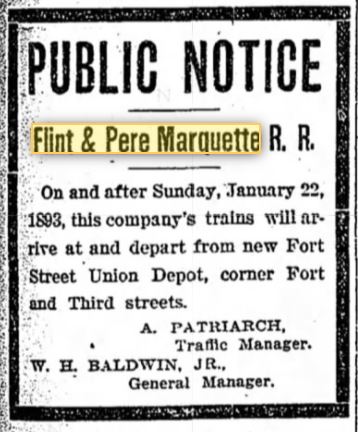- Details
- Hits: 4235
Station: Fort Street Union Station, Detroit, MI
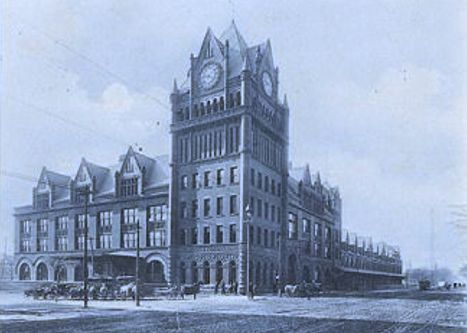
DetroitPostcard.jpg)
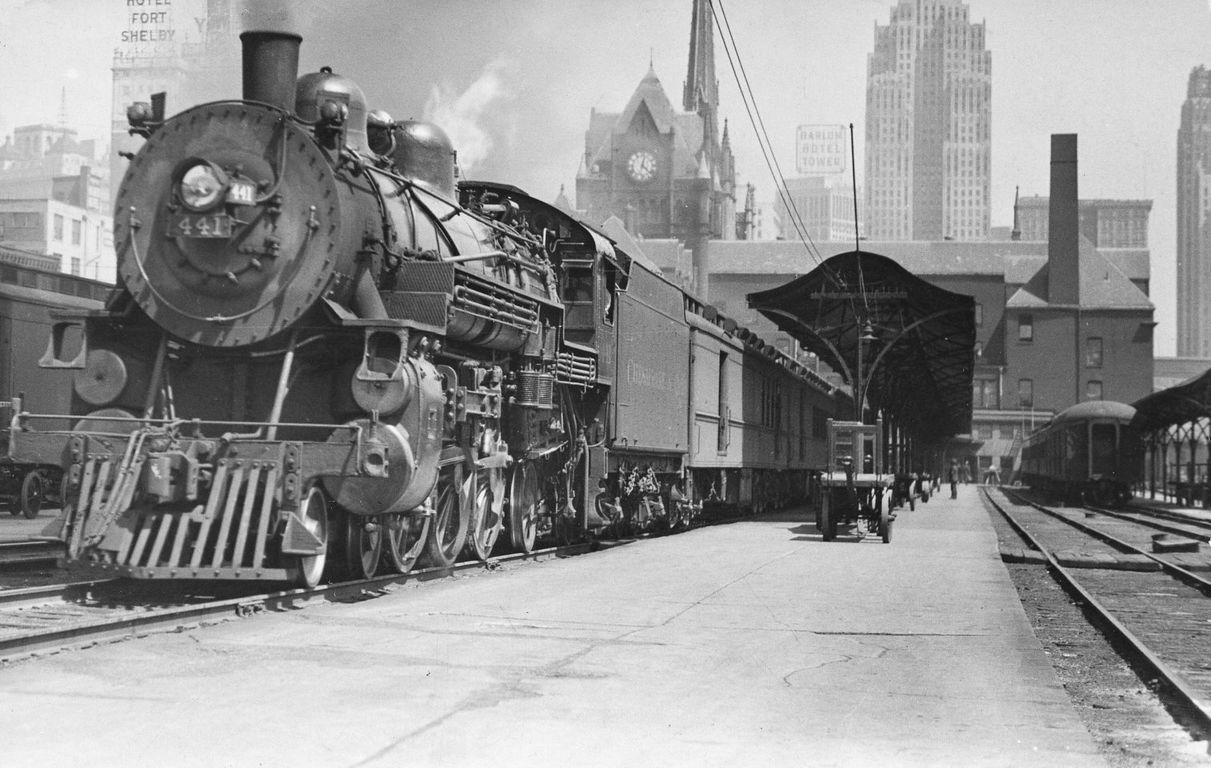

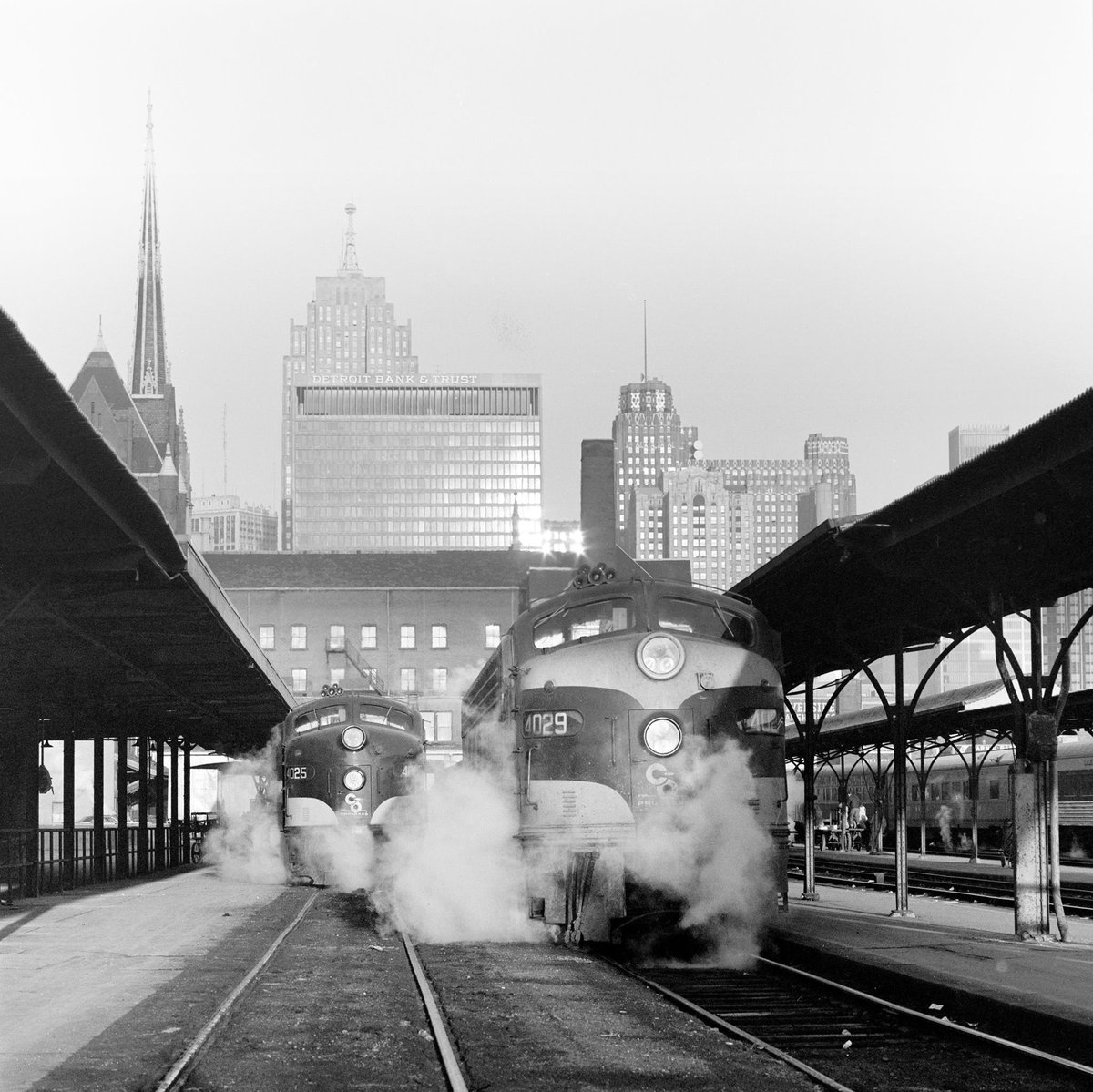
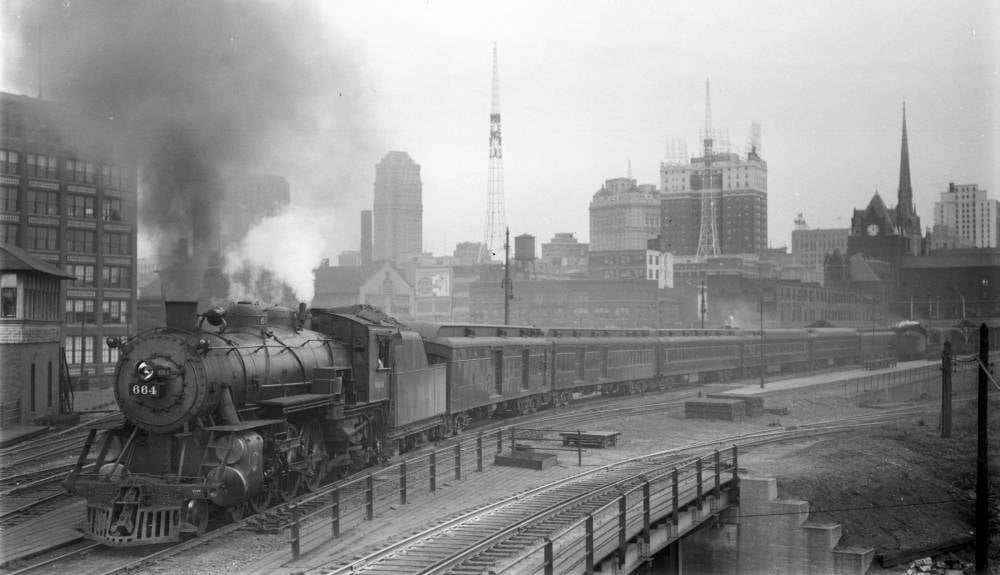
 Fort Street Union Station was located on the corner of Fort Street and 3rd Street near the riverfront in downtown Detroit. This was a stub-end station at the end of the Union Belt railroad, which was jointly operated by the Pere Marquette, Pennsylvania and Wabash railroads. The Baltimore and Ohio also used the station for a short period after their merger with the C&O. The depot began construction in 1891 and opened to the public January 21, 1893.
Fort Street Union Station was located on the corner of Fort Street and 3rd Street near the riverfront in downtown Detroit. This was a stub-end station at the end of the Union Belt railroad, which was jointly operated by the Pere Marquette, Pennsylvania and Wabash railroads. The Baltimore and Ohio also used the station for a short period after their merger with the C&O. The depot began construction in 1891 and opened to the public January 21, 1893.
Photo info: Top, two postcard views of the Union Depot in Detroit. 2nd photo, a 1966 view of the station platforms and train shed. [Charles Geletzke Jr]; 3rd photo, C&O Pacific 4441 is ready to pull out of FSUD in the 1920's. [Charlie Whipp collection]. 4th photo, two C&O trains awaiting to depart FSUD in the 1960's.. 5th photo, Wabash train 79, led by Engine 664, leaves FSUD in 1939. Note a view of 6th Street tower at the left. [Otto Perry photo]. 6th photo, a 1893 notice announcing the use of the new station. [DFP]; 7th photo, another view of Wabash No. 79 leaving FSUD in 1939. [Otto Perry]
Notes
The railroad entrance to this station was controlled by the 6th Street Interlocking tower.
Location: 42o19.640'N / 83o03.267'W.
The depot viaduct was built in 1891. The original length was 3,187 feet but was shortened to 2,513 feet by filling the ends. [PM45]
Architect James Stewart, designed the building in a Romanesque Revival style.
Additional Information:
The following is an article from the February 2, 1946 edition of Railway Age, submitted by Jeff Feldmeier:
Begin Remodeling of Detroit Station
More convenience and space is objective of $500,000 one-year program
Involving a total cost of $500,000 and several months of planning, a modernization project for the Fort Street Union Station in Detroit, Mich., has been started and is expected to be completed within a year. The work is being carried on by the Walbridge, Aldinger Company, Detroit, under the supervision of M. M. Cronk and O. E. Hager, general manager and chief engineer, respectively, of the Fort Street Union Depot Company.
The station is used by the trains of the Pennsylvania, the Pere Marquette and the Wabash. In addition to trains which the Pere Marquette operates on its own lines, it also operates through trains in and out of the station in conjunction with the Baltimore & Ohio and the Chesapeake & Ohio by way of Toledo, Ohio.
The principal objective of the remodeling plan consists of the removal from the ground floor of many functions not essential to the welfare of the traveling public and which now occupy space badly needed for public accommodations. Under the present set-up, the ground floor is occupied by the ticket office, restaurant, newsstand, Travelers' Aid station, information counter, ladies' room, check room, and the offices of the stationmaster, passenger agent, Pullman agent, ticket agent station accountants, restaurant kitchen, storeroom and other miscellaneous functions. All of these not considered essential to direct public use will be removed to a newly-constructed second floor, provisions for which will be made by erecting a new ceiling over the waiting room at a height of one and one-half stories. The work will also include building of a new train gate wall with large and direct exits at either end and six large doors leading to the waiting room.
Old views of Fort Street Union Station:
Dale Berry recommends watching an early 1970's movie "Detroit 9000" to see views of Fort Street Union Station and 6th Street interlocking tower after they were abandoned. This is a cops and robbers movie which was filmed in cooperation with the City of Detroit. Some of the chase scenes and gun battles at the end of the movie are at the old station and around the interlocking tower. A mounted police officer gallops down the railroad right-of-way! Its a pretty bad movie but its fun to see the old footage. They shoot out an awful amount of glass in the depot. The movie is available at Amazon for about $10.
Time Line
1889. The Board of Railroad Crossings decided in favor of an overhead crossing of the Union Depot Company over the Michigan Central Third Street depot approach tracks. The two railroads have been jockeying for position on the matter with the MC seeming to delay the crossing. Note that Mr. Joy, a prominent railroad attorney in Detroit, was attorney for the Michigan Central and other railroads until they were taken over by the Vanderbilt organization. He then joined other railroads including the Wabash railroad which built into Detroit.
MC President Ledyard explained the position taken by the Michigan Central railroad as follows: "The situation is just this: The Union Depot Company wants to cross our tracks. We say, 'Very well, gentlemen, how do you propose to do it? Let us see your plans. We are perfectly willing for you to do this, provided you do not erect such a structure as well endanger the lives of our employees and unnecessarily injure our property.
What reply does the Union Depot Company make? Does Mr. Joy submit any definite plan? No, he does not. I am shown a ground plan, showing two rows of posts, placed alongside of our tracks thirty feet apart. I am not even informed how high these posts are to be. My knowledge of engineering tells me that this would never do. I might remark here that I had the benefit of a complete course of civil engineering at West Point, and probably know as much about engineering as Mr. Joy.
"It is suggested that we take up one of our tracks or change its course. We could not do that. Every single track laid on Woodbridge street is necessary to us in order to transact our business. These tracks were not laid for fun. Moreover, every bit of room has been economized so that if we change the course of one track it would be necessary to change all. I have offered to arbitrate any disputed question that may arise between the two companies. This offer has been refused.
"This is the present situation: The State Board of Railroad Crossings have the power to say how the union depot lines shall cross our tracks, if they cross at all. This board has decided in favor of an overhead crossing, but has not yet approved any particular plan. It now remains for a particular plan to be decided upon, and when decided upon, it will be submitted to Commissioner Rich for approval. If the Union Depot Company chooses to confer with us, we will meet in a friendly spirit and try to agree upon a plan. If we succeeded in so doing, and secured Commissioner Rich's approval, that would end the matter.
If, on the other hand, the Union Depot Company refused to meet us, and prefers to draw up a plan of its own, the only course left us is to do likewise. That appearing to be the course they intend to follow, I have instructed our engineer, Mr. Hawks, to prepare the very best plan he can, and I told him to act in the matter as though he were a disinterested expert, rather than the Michigan Central's engineer.
"If the Union Depot Company, then, does not choose to confer with us with a view to agreeing upon a plan, the result will be two plans, one prepared by them, and one by us. These will be submitted to Commissioner Rich. In case the commissioner should approve the Union Depot company's plan and reject ours the situation would stand thus: if we deemed their plan free from, the objections I spoke of, namely, as being dangerous to our employee's lives and unnecessarily injurious to our property, why then the work could go on at once. But if it was open to these objections, then the Union Depot Company would be obliged to condemn the right to cross our tracks, which means a resort to the court. But even then we should prefer to arbitrate the matter. I don't want to go to the courts if I can help it. I am willing to leave the drawing up of a plan to two engineers, one to be chosen by each party, and in case they fail to agree, the matter to be decided by a third engineer to be chosen by the other two. It must be borne in mind that the Railroad Commissioner has no authority to compel one railroad to submit to another's crossing it. He can simply say how it shall cross. If the owners of the property to be crossed object, then the courts must be resorted to, if the parties are unwilling to arbitrate.
"I have large interests in Detroit, and I am glad to see these roads come here. I have never in my life raised a hand to obstruct any such project. But at the same time I am bound to protect the interest of the 12,000 or 13,000 stockholders in the Michigan Central railroad. We are willing to let these roads should cross ours, provided the crossing be properly constructed, no matter what the particular form of structure may be. All we ask is that due regard for the lives and limbs of our men be observed.
"As far as Mr. Joy is concerned, I bear him no animosity. I have always entertained the highest opinion of his ability. He is one of the greatest men Detroit ever had. The people of Detroit may not know that for six years, I was Mr. Joy's pupil. I told Mr. Joy the other day that he ought to be ashamed of himself for bringing up such a bad boy."
Ashley Pond was asked if the Michigan Central intended to oppose the depot company in carrying out the plans approved.
"We have never opposed the Union Depot Company," said Mr. Pond. "As I have said before, we are perfectly willing to meet any representative of that company for the purpose of discussing and agreeing upon a plan that will be the most satisfactory to both parties, and he attended with the least injury and danger to both. In case we do so meet and fail to agree upon a structure, the matter will be referred to the Railroad Commissioner, who will decide which is the best plan. [DFP-1889-1110]
1891. January 1. Mr. Webber, who is a director of the Flint & Pere Marquette road and its counsel said: "Our road will be one of those occupying the new Fort Street union depot. We have long sought an entrance into Detroit [independent from the DL&N] and have that hope; but I cannot say when operations will begin. [DFP-1891-0101]
1891. March 8. The directors of the Fort Street Union Depot Company met yesterday in the office of President James F. Joy in the Hammond building and opened proposals for the contract to construct the depot building. There was full attendance of the directors W. W. Crapo and H. C. Potter, Flint & Pere Marquette; J. Shaughnessy, Canadian Pacific, C. M Heald, Detroit, Lansing & Northern, and James F. Joy, Wabash. The lowest tender was made by Henry George & Son of Detroit. There were nine other bidders, five of which were from Detroit. The builder will employ 150 to 200 men. The structure will be four stories high, with a 166 foot frontage on Third street and 135 feet on Fort street. The entire building will have a frontage of 492 feet on Fort. [DFP-1891-0308]
1893. An event to celebrate the opening of FSUD will offer tours of the new station as well as a musical program which will be rendered by the Fort Wayne Band, nineteenth United States Infantry next Saturday evening. [DFP-1893-0114] Station opened on January 21, 1983. The depot yard contains nine tracks with a 66 car capacity. [PM45]
1893. The F&PM announce in a public notice that their trains will begin using the Fort Street Union Depot at the corner of Fort and Third streets on Sunday, January 22, 1893. [DFP-0121] The station was officially opened on Saturday, January 21, 1893. [SJH-1893-0128] Eighteen trains per day are using the depot. [DFP-1893-0129]
1904. In a lawsuit by the Pere Marquette railroad against the Wabash railroad and the Detroit Union Railroad Depot & Station Company, Judge Brooke ordered that the PM and Wabash will have equal rights in the Union depot ground the tracks. [PHTH-1904-0521]
1946. The depot was renovated adding a restaurant, fluorescene light, a baggage room, train gates and other amenities.
1950's. The Wabash ran two round trips into Fort Street Union Station including the "Cannonball" from Fort Wayne, IN and Decatur, IL. These trains lasted until the early 1960's. [TSD]
1950's. Cobo Hall was built to the south of the station and the Lodge Freeway was tunneled beneath the railway tracks.
1964. October 5. Baltimore & Ohio passenger trains begin using FSUD, moving from the Michigan Central station. One Saturday train continues to use MC station to retain station and trackage rights. B&O power, which had been serviced at NYC's Livernois Yard now moves to Rougemere Yard. TSD]
1971. May 1. The last train departs this station. [CQII]
1974. January. The building was demolished.
Bibliography
The following sources are utilized in this website. [SOURCE-YEAR-MMDD-PG]:
- [AAB| = All Aboard!, by Willis Dunbar, Eerdmans Publishing, Grand Rapids ©1969.
- [AAN] = Alpena Argus newspaper.
- [AARQJ] = American Association of Railroads Quiz Jr. pamphlet. © 1956
- [AATHA] = Ann Arbor Railroad Technical and Historical Association newsletter "The Double A"
- [AB] = Information provided at Michigan History Conference from Andrew Bailey, Port Huron, MI

